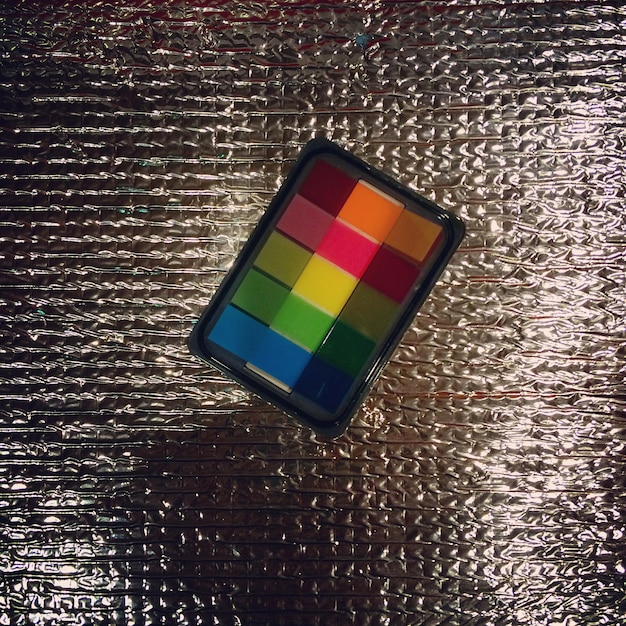Gaming Monitor Calibration: Master Perfect Colors Free

Achieve unparalleled visual accuracy and immersion in gaming by meticulously calibrating your monitor’s colors and contrast using readily available, free software tools, ensuring every pixel appears as intended by developers.
For gamers, visual fidelity transcends mere aesthetics; it’s intricately linked to performance and immersion. Uncalibrated monitors often display inaccurate colors, washed-out contrast, and details lost in shadows or blown-out highlights, creating a subpar experience. This guide empowers you to master gaming monitor calibration: achieve perfect colors and contrast with this free tool, transforming your visual landscape without spending a dime.
Why Calibration is Crucial for Gaming Monitors
Understanding why monitor calibration is essential for gaming goes beyond simply making things “look pretty.” It’s about ensuring that the visual information delivered to your eyes is as accurate as possible, directly impacting gameplay, immersion, and even competitive advantage.
Many gaming monitors come with factory settings that are far from optimal. These default profiles are often designed for general use or to simply “pop” on a retail shelf, prioritizing oversaturated colors or excessive brightness over true color reproduction and accurate contrast. This leads to a disconnect between what game developers intended you to see and what your monitor actually displays.
Impact on Visual Fidelity and Immersion
- True Color Representation: Games are crafted with specific color palettes and lighting effects to evoke certain moods or convey information. An uncalibrated monitor might shift hues, making environments appear unnatural or character details less distinct.
- Enhanced Contrast and Detail: Proper calibration ensures that the darkest shadows aren’t crushed into an indistinguishable black blob and the brightest highlights retain detail, revealing subtle nuances in game worlds that might otherwise be missed. This is particularly vital in games where spotting enemies or interactive elements depends on precise visual cues.
- Consistent Experience: When you watch a game trailer or see screenshots, they are usually viewed on calibrated displays. Calibration helps your monitor reproduce that intended visual experience, ensuring consistency with the developer’s vision.
Competitive Edge and Eye Health
Beyond aesthetics, calibration can offer tangible benefits in competitive gaming. Being able to clearly distinguish enemy models from background elements, identify subtle environmental changes, or accurately gauge distances can make a critical difference. Colors that are too saturated or too dim can also lead to eye strain and fatigue during long gaming sessions, impacting your focus and overall well-being. A properly calibrated monitor reduces this strain by presenting a more natural and comfortable image.
Ultimately, investing a small amount of time in calibrating your gaming monitor unlocks its full potential, transforming your visual experience from merely acceptable to truly exceptional. It’s a foundational step towards achieving the perfect gaming setup, ensuring every detail, every color, and every shadow contributes to the immersive world the developers worked so hard to create.
Understanding Color Spaces and Gamma
To embark on the journey of monitor calibration, a fundamental understanding of color spaces and gamma is indispensable. These concepts form the bedrock of accurate color reproduction, directly influencing how vivid and true-to-life your game worlds appear.
A color space, at its core, defines the range of colors a display can produce. Think of it as a specific set of rules or coordinates that map out every perceivable color. While various color spaces exist, two are predominantly relevant for consumer displays and gaming:
sRGB: The Web Standard
- Ubiquitous and Baseline: sRGB is the most common color space, adopted as the standard for the internet, most consumer electronics, and a vast majority of video games.
- Good Starting Point: If your monitor is calibrated to sRGB, you’re ensuring that colors in nearly all games and web content will appear as intended. Most free calibration tools and advice will target sRGB as the primary color space.
- Limited Gamut: While widespread, sRGB has a relatively smaller color gamut (range of colors) compared to professional standards. For gaming, this is rarely an issue as few games currently leverage wider gamuts.
Adobe RGB and DCI-P3: Wider Gamuts
Some higher-end gaming monitors boast wider color gamuts, often covering Adobe RGB or DCI-P3. While these offer a broader spectrum of colors, it’s crucial to understand their interaction with content. If your monitor is set to a wide gamut but displaying sRGB content, the colors may appear oversaturated and unnatural unless specifically managed by the application or operating system. For most gamers, ensuring accurate sRGB rendition is the priority.
What is Gamma?
Gamma, on the other hand, describes the relationship between the input signal and the output brightness of a display. In simpler terms, it dictates how quickly shades of gray progress from black to white. It controls the perceived brightness of mid-tones. An incorrect gamma setting can make images appear:
- Washed Out: If gamma is too low, mid-tones become too bright, making the image look faded or lacking depth.
- Too Dark/Crushed: If gamma is too high, mid-tones become too dark, crushing details in shadows and making the image appear overly contrasty.
- Standard Gamma (2.2): For PC gaming and Windows environments, a gamma of 2.2 is the widely accepted standard. Calibrating to this value ensures that shadow and highlight details are preserved and presented correctly, contributing significantly to visual realism and clarity in various gaming environments.
By understanding and correctly configuring your monitor’s color space (primarily sRGB) and gamma (2.2), you lay the groundwork for accurate and visually striking gaming experiences. These adjustments directly influence the mood, atmosphere, and even the competitive clarity of your favorite titles, moving you closer to the developer’s artistic vision.

Preparing Your Monitor for Calibration
Before diving into the specifics of using a calibration tool, proper preparation of your monitor and environment is critical. Neglecting these preliminary steps can lead to inaccurate readings and suboptimal results, undermining all your efforts. Think of this as setting the stage for a perfect performance.
First and foremost, it’s about consistency. Your monitor’s performance can be influenced by external factors, and minimizing these variables ensures that your calibration is robust and reproducible.
Environmental Considerations
- Lighting Conditions: Calibrate your monitor in the lighting conditions you most frequently game in. Ideally, this should be consistent, moderate, and indirect. Avoid direct sunlight or strong overhead lights hitting your screen, as they can alter perceived colors and contrast. A moderately dim, consistent ambient light is often recommended.
- Warm-Up Time: Allow your monitor to warm up for at least 30 minutes, ideally an hour, before beginning the calibration process. Just like any electronic device, a monitor’s display characteristics can shift slightly as it reaches its optimal operating temperature. Calibrating a “cold” monitor can result in inaccurate settings once it’s fully warmed up.
- Cleanliness: Ensure your monitor screen is free of dust, smudges, and fingerprints. Even minor blemishes can interfere with visual assessment and calibration readings. Use a soft, lint-free cloth and a specialized screen cleaner if necessary.
Monitor Settings Adjustments
Before running any software, reset your monitor to its factory defaults. This provides a clean slate, removing any previous, potentially incorrect manual adjustments. Navigate through your monitor’s OSD (On-Screen Display) menu to find the “Reset” or “Factory Reset” option.
Next, it’s beneficial to manually set some foundational parameters:
- Brightness: Adjust brightness to a comfortable level. For most gaming environments, a brightness of 120-160 cd/m² (candelas per square meter) is often a good starting point. Many calibration tools will help you fine-tune this, but a rough initial setting is helpful.
- Contrast: Set your monitor’s contrast to its default (usually 50%). Avoid pushing it too high, which can crush whites and lose detail in highlights, or too low, which can wash out the image.
- Color Temperature/Preset: If your monitor has various color temperature presets (e.g., “Warm,” “Cool,” “User”), select “User” or a custom mode. This allows the calibration tool to make precise adjustments without being constrained by an existing, often inaccurate, preset. Avoid “Dynamic Contrast” or “Game Mode” picture enhancements during calibration, as they often apply artificial processing that distorts true color. Disable all such enhancements temporarily.
By meticulously preparing your monitor and its environment, you create the optimal conditions for the free calibration tool to perform its magic effectively. This critical preparatory stage sets the foundation for achieving genuinely perfect colors and contrast, ensuring your final calibrated display accurately reflects the visual intentions of game developers.
Introducing DisplayCAL: Your Free Calibration Companion
When it comes to free, robust, and highly capable monitor calibration software, DisplayCAL stands out as the undisputed champion. While it might appear daunting at first glance due to its comprehensive features, its power lies in its precision and versatility, making it the ideal choice for gamers aiming for professional-grade color accuracy without the professional price tag.
DisplayCAL is open-source software, meaning it’s developed and maintained by a community, constantly evolving and improving. It works in conjunction with a colorimeter – a hardware device that measures the light emitted from your monitor screen. While the software is free, a colorimeter is a necessary investment, but it’s a one-time purchase that unlocks true calibration. Popular choices include the X-Rite i1Display Pro (often available used or refurbished) or the Spyder series from Datacolor, which are widely supported by DisplayCAL.
Key Features and Advantages
- Extensive Hardware Support: DisplayCAL supports a vast array of colorimeters and spectrally-based sensors, ensuring compatibility with most devices on the market.
- Advanced Calibration Algorithms: Unlike simpler tools, DisplayCAL uses sophisticated algorithms to create highly accurate ICC (International Color Consortium) profiles. These profiles tell your operating system how to render colors correctly on your specific monitor.
- Detailed Reporting: After calibration, DisplayCAL provides comprehensive reports on your monitor’s performance, allowing you to see its color accuracy, gamma curve, and other critical metrics.
- Profile Verification: It allows you to verify your created profile to ensure its accuracy, providing objective measurements of how well your monitor is performing post-calibration.
How DisplayCAL Works (Simplified)
DisplayCAL facilitates a two-step process: calibration and profiling. Calibration involves adjusting your monitor’s internal settings (brightness, contrast, and RGB gains) to achieve specific targets like a gamma of 2.2 and a white point of D65 (6500K). Profiling then measures the monitor’s unique color response across its entire gamut after calibration, creating an ICC profile that corrects any remaining color inaccuracies at the operating system level.
The software generates a series of color patches on your screen, which the colorimeter measures. Based on these measurements, DisplayCAL guides you through adjusting your monitor’s OSD settings or makes corrections via graphics card LUTs (Look-Up Tables) to achieve the desired color and luminance targets. The process ensures that every color you see is rendered with utmost precision.
While DisplayCAL might seem complex initially, following a step-by-step guide and understanding its purpose will demystify the process. Its free nature coupled with its powerful capabilities makes it an indispensable tool for any serious gamer or professional seeking accurate color reproduction.
Step-by-Step Calibration Process with DisplayCAL
Empowering your gaming monitor with perfect colors and contrast involves a systematic approach using DisplayCAL. This step-by-step guide will walk you through the process, ensuring you achieve optimal visual fidelity. Remember to have your colorimeter connected and warmed up, and your monitor reset to factory defaults as per the preparation steps.
The initial setup within DisplayCAL involves selecting your display and calibration targets. This is where you specify what kind of color accuracy you’re aiming for.
Setting Up DisplayCAL for Calibration
- Software Launch: Open DisplayCAL. On the main “Display & instrument” tab, ensure your colorimeter is detected under “Instrument.” Select your primary display under “Display.”
- Calibration Settings: Navigate to the “Calibration” tab. Here, you’ll define your targets:
- Whitepoint: Set this to “D65” (6500K), which is the standard for most content.
- Gamma: Select “Gamma 2.2.” This is crucial for PC gaming and Windows.
- Luminance: Aim for a luminance value between 120-160 cd/m². Start at 120 cd/m² and adjust up to your preference for your lighting environment.
- Black Level: Keep this on “As measured” or “Lowest possible.”
- Profiling: Choose “XYZLUT + matrix” for optimal accuracy.
- Start Calibration: Click the “Calibrate & profile” button. DisplayCAL will then present a series of colored patches and prompt you to place your colorimeter on the designated area of your screen.
Adjusting Your Monitor’s OSD During Calibration
DisplayCAL will guide you through making manual adjustments using your monitor’s OSD (On-Screen Display) menu. This is the most crucial part for achieving a hardware-level calibration:
- Brightness Adjustment: The software will first instruct you to adjust your monitor’s brightness until it reaches your target luminance (e.g., 120 cd/m²). Use the brightness slider in your monitor’s OSD.
- RGB Gain Adjustment: DisplayCAL will then present a screen with Red, Green, and Blue sliders. You’ll need to locate your monitor’s “RGB Gain” or “Color Balance” settings within its OSD. Adjust these sliders according to DisplayCAL’s instructions until the corresponding red, green, and blue values are balanced, indicating a neutral white point. This step is critical for eliminating color casts.
- Contrast Adjustment: The software may also prompt for contrast adjustments, ensuring that both black and white details are well-preserved without clipping.
After these manual adjustments are complete, DisplayCAL will proceed to the profiling phase. It will measure hundreds or thousands of color patches across your screen, calculating the precise corrections needed. This process can take anywhere from 10 to 30 minutes, depending on the number of patches and sensor speed. Once complete, DisplayCAL will ask you to install the generated ICC profile. Always accept this, as it’s the file your operating system uses to ensure correct color display.
The result of this meticulous process is a highly accurate ICC profile that corrects color discrepancies at the system level. This profile loads automatically upon Windows startup, ensuring your monitor always displays content with the perfect colors and contrast you’ve painstakingly calibrated for, enhancing every aspect of your gaming experience.
Verifying and Maintaining Your Calibration
Once you’ve meticulously calibrated your gaming monitor with DisplayCAL, the journey isn’t quite over. Verifying the accuracy of your new profile and understanding how to maintain it are crucial steps to ensure your visual experience remains consistently pristine.
Verification provides objective proof that your calibration has been successful, quantifying the improvements made to your display’s color accuracy and contrast. It’s like a quality control check after a big renovation.
Checking Your Calibration Accuracy
- DisplayCAL’s Verification Tool: DisplayCAL itself offers a robust verification option. After creating and installing your ICC profile, go to the “Verification” tab within the software. You can run a test that measures a series of color patches and compares them against target values, generating a detailed report.
- Delta E (dE) Values: Look for low Delta E values. dE represents the perceived difference between two colors. A dE value of < 1.0 is generally imperceptible to the human eye, while anything below 3.0 is considered good for most purposes. Lower numbers indicate higher accuracy.
- Gamma Curve: Check that your gamma curve closely matches the targeted 2.2 for smooth, accurate mid-tone reproduction.
- White Point Accuracy: Confirm that your white point is close to D65 (6500K) for neutral whites and grays.
- Visual Inspection: While objective measurements are key, also trust your eyes. Test your newly calibrated monitor with familiar games, high-quality images, and videos. Look for natural skin tones, deep blacks, detailed shadows, and vibrant (but not oversaturated) colors. The difference should be noticeable and positive, with a feeling of enhanced realism and depth.
Maintaining Your Calibration
Monitor calibration isn’t a “set it and forget it” process. Over time, display characteristics can drift due to temperature changes, component aging, and even firmware updates. Regular recalibration is necessary to maintain accuracy.
- Recalibration Frequency: For most gaming monitors and typical usage, recalibrating every 1-3 months is a good practice. If you game extensively or are sensitive to subtle color shifts, you might consider calibrating more frequently.
- Environmental Consistency: Try to maintain consistent lighting conditions in your gaming space. Drastic changes in ambient light can affect how you perceive your display, even if it’s perfectly calibrated.
- Software Updates: Keep your graphics drivers and DisplayCAL software updated. New versions often bring performance improvements or bug fixes that can affect color management.
- Hardware Health: Be aware that if your monitor starts exhibiting significant color shifts or other anomalies that cannot be corrected by calibration, it might indicate a hardware issue or the monitor reaching the end of its lifespan.
By regularly verifying and maintaining your monitor’s calibration, you ensure that your gaming experiences consistently benefit from accurate colors and contrast. This diligent approach guarantees that every pixel you see contributes to the immersive and visually rich worlds game developers strive to deliver, providing a perpetual edge in both aesthetics and competitive play.

Troubleshooting Common Calibration Issues
Even with the most precise tools and careful procedures, you might encounter issues during or after monitor calibration. Recognizing and resolving these common problems is key to achieving and maintaining your desired visual perfection. Don’t be discouraged if your initial attempts aren’t flawless; troubleshooting is a normal part of the process.
Many calibration issues stem from either environmental factors or incorrect software settings. A systematic approach to diagnosis often leads directly to the solution.
Issues During Calibration
- Colorimeter Not Detected: Ensure your colorimeter is properly plugged into a USB port. Try a different port or restart your computer. Make sure DisplayCAL is the only software trying to access the device. Sometimes, installing the latest drivers for your colorimeter can resolve detection issues.
- Inaccurate Readings/Flickering Patches: Strong ambient light hitting the screen can interfere with the colorimeter’s readings. Close blinds, turn off overhead lights, and ensure no direct light sources are illuminating the screen. Also, check for screen reflections.
- Unable to Reach Target Luminance/White Point: If DisplayCAL indicates you can’t reach your target brightness or color temperature (white point) by adjusting your monitor’s OSD, your monitor might have physical limitations. Try adjusting the target luminance (e.g., from 120 cd/m² to 140 cd/m²) or selecting a slightly different white point (e.g., “Native” instead of D65 if D65 is proving problematic for your specific display). Ensure “Dynamic Contrast” or similar image “enhancements” are disabled in your monitor’s OSD.
Post-Calibration Issues
- Colors Still Look Off/Washed Out/Oversaturated:
- Profile Not Loading: Ensure the ICC profile generated by DisplayCAL is correctly installed and set as the default for your display in Windows Color Management. Sometimes conflicting color management software can cause issues.
- Application Overriding Profile: Some applications (especially certain games or image editors) might use their own internal color management or ignore system profiles. Check their settings. For games, this is rare, but good to be aware of.
- Viewing sRGB Content on Wide Gamut Display: If you have a wide gamut monitor but DisplayCAL calibrated it for sRGB (which is common and recommended for gaming), make sure your applications are respecting the sRGB profile. Otherwise, sRGB content might appear oversaturated.
- Loss of Detail in Shadows/Highlights (Crushed Blacks/Blown Whites): This often indicates a gamma mismatch or incorrect contrast setting. Recheck your gamma target (it should be 2.2 for PC) and ensure your monitor’s contrast setting wasn’t pushed too high or too low during calibration. Rerunning the calibration focusing on these parameters can help.
- Profile Not Sticking After Restart: Ensure the DisplayCAL Profile Loader (which it usually installs automatically) is running at startup. Check your Windows Task Scheduler or Startup apps if the profile isn’t loading automatically.
By systematically addressing these potential issues, you can fine-tune your calibration process and ensure your gaming monitor consistently delivers the precise, vibrant, and perfectly contrasted images you desire, enhancing every moment of your gaming experience.
Beyond Calibration: Advanced Tips for Immersive Gaming Visuals
While calibrating your gaming monitor is the cornerstone of achieving perfect colors and contrast, several advanced tips and considerations can elevate your visual experience even further. These aren’t direct calibration steps but rather complementary practices that leverage your newfound color accuracy for maximum immersion and enjoyment.
Once your monitor is displaying colors precisely, you can focus on optimizing how individual games and your graphics card settings interact with this accurate foundation.
Optimizing Graphics Card Settings
- NVIDIA Control Panel / AMD Radeon Software: After calibration, ensure your graphics card drivers are not overriding your system’s color management. In NVIDIA Control Panel (or AMD Radeon Software), go to “Adjust desktop color settings.” Select “Other applications control color settings” to allow your ICC profile to take precedence. Avoid applying artificial “digital vibrance” or color boosts here, as they counteract the accuracy of your calibration.
- Refresh Rate and Resolution: While not directly related to color, ensure your display is running at its native resolution and highest refresh rate. A calibrated image at 144Hz or 240Hz provides a smoother, more responsive visual experience that complements accurate colors.
In-Game Visual Settings
Modern games often feature extensive graphical settings that can significantly impact visual fidelity. With a calibrated monitor, you can make more informed decisions about these settings, focusing on those that enhance realism and detail rather than compensating for a poor display.
- HDR Settings: If your monitor supports HDR (High Dynamic Range), and you’re playing an HDR-enabled game, a calibrated SDR (Standard Dynamic Range) profile is still important as Windows often converts SDR content to HDR. However, proper HDR display requires specific HDR calibration tools and considerations, as HDR is a separate visual pipeline. Ensure your monitor’s HDR mode is correctly configured and that Windows is set for HDR.
- Anti-Aliasing, Textures, and Lighting: With accurate colors, you can better appreciate the nuances of high-resolution textures, realistic lighting (such as ray tracing), and effective anti-aliasing. Experiment with these settings to find the balance between visual quality and performance that suits your hardware.
- In-Game Brightness/Contrast Sliders: Most games include their own brightness and contrast sliders. After calibration, treat these as fine-tuning controls. Generally, leave them at their defaults or make minimal adjustments unless the game specifically recommends it (e.g., “adjust until logo is barely visible”). Never use them to compensate for an uncalibrated monitor.
By combining a meticulously calibrated monitor with optimized graphics card settings and intelligent in-game adjustments, you unlock a superior level of visual fidelity. This holistic approach ensures that every pixel on your screen contributes to a truly immersive and breathtaking gaming experience, allowing you to fully appreciate the artistry and technical prowess behind your favorite titles.
| Key Point | Brief Description |
|---|---|
| 🎨 Color Accuracy | Ensures games display colors as intended by developers, enhancing realism and immersion. |
| 👁️🗨️ Enhanced Contrast | Reveals detail in shadows and highlights, preventing crushed blacks or blown-out whites. |
| 🛠️ Free Tool: DisplayCAL | Open-source software that provides professional-grade calibration with a colorimeter. |
| 🔄 Maintenance | Recalibrate every 1-3 months to counteract display drift and maintain visual precision. |
Frequently Asked Questions
▼
While some manual adjustments can be made by eye, a colorimeter is essential for truly accurate monitor calibration. It’s a hardware device that objectively measures colors and light from your screen, allowing software like DisplayCAL to create a precise ICC profile that your operating system uses to display correct colors. Without it, you’re largely guessing.
▼
The initial calibration process with DisplayCAL, including manual adjustments and profiling, can take anywhere from 15 to 45 minutes, depending on your monitor’s response speed and the number of patches measured. Subsequent recalibrations are generally quicker as the software often remembers previous settings, but it’s still a process that requires some dedicated time.
▼
No, monitor calibration itself does not affect your game’s frame rate (FPS) or overall performance. The ICC profile created by DisplayCAL is loaded at the operating system level and simply tells your graphics card how to interpret and display colors. It’s a color transformation, not a rendering process that consumes significant GPU resources. Your games will run at the same speed.
▼
No, once your monitor is calibrated, the created ICC profile is applied system-wide. This means all applications, including every game you play, will benefit from the accurate color and contrast settings. You do not need to recalibrate for individual games. However, it’s recommended to periodically recalibrate your monitor (e.g., every 1-3 months) to account for display drift.
▼
While DisplayCAL can calibrate an HDR monitor for its SDR (Standard Dynamic Range) capabilities, true HDR calibration is more complex and not fully supported by DisplayCAL in the same way. HDR standards involve specific luminance targets and metadata that traditional SDR calibration tools aren’t designed to handle robustly. For optimal HDR, you might need specialized software and a high-end colorimeter capable of HDR measurements.
Conclusion
Achieving perfect colors and contrast on your gaming monitor transforms your visual experience from merely seeing to truly immersing yourself in the rich, detailed worlds game developers meticulously craft. While the journey involves a learning curve and the one-time investment in a colorimeter, the reward of an accurately calibrated display is immeasurable. Embracing tools like DisplayCAL empowers you to unlock your monitor’s full potential, ensuring every shade, every shadow, and every highlight contributes to a more authentic, captivating, and competitive gaming adventure. Consistent verification and maintenance guarantee that this visual excellence endures, making calibration an indispensable practice for any serious gamer.





